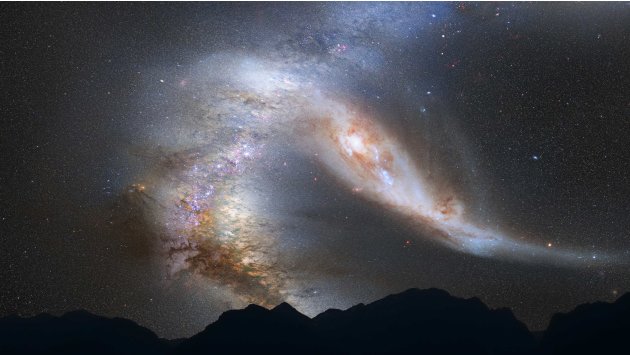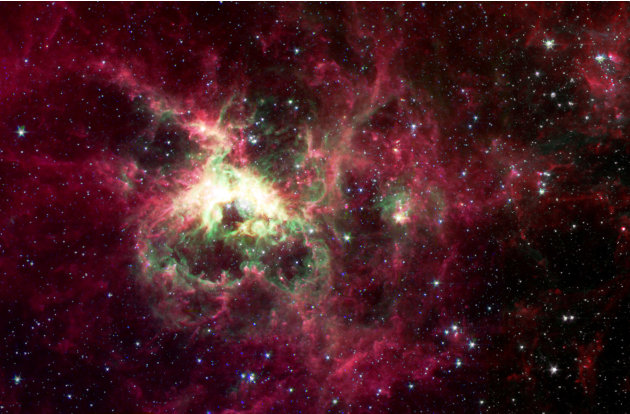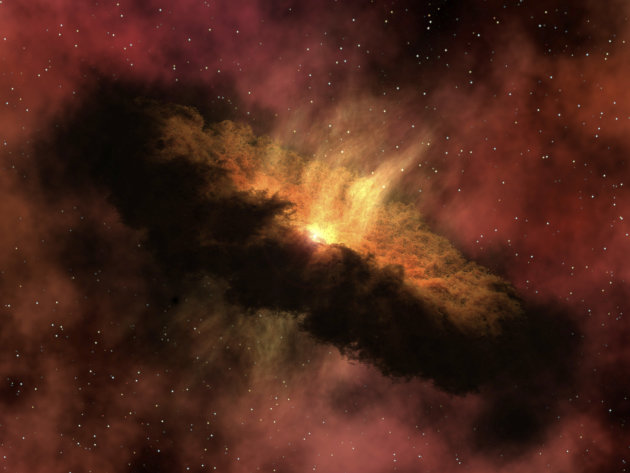Galaksi Bima Sakti akan bertabrakan dengan galaksi berukuran sama, Andromeda. Para astronom mengumumkan hal ini pada 31 Mei. Setelah selesai, tubrukan antargalaksi ini akan menciptakan galaksi hibrida baru.

The sky is seen at night just
before the predicted merger between our Milky Way galaxy and the
neighboring Andromeda galaxy, in this NASA photo illustration released
May 31, 2012. About 3.75 billion years from now, Andromeda's disk will
fill the field of view and its gravity will begin to create tidal
distortions in the Milky Way. The view is inspired by dynamical computer
modelling of the future collision between the two galaxies. The two
galaxies collide about 4 billion years from now and merge to form a
single galaxy about 6 billion years from now. REUTERS/NASA, ESA, Z.
Levay and R. van der Marel (STScI), and A. Mellinger/Handout
(ENVIRONMENT SCIENCE TECHNOLOGY TPX IMAGES OF THE DAY) FOR EDITORIAL USE
ONLY. NOT FOR SALE FOR MARKETING OR ADVERTISING CAMPAIGNS. THIS IMAGE
HAS BEEN SUPPLIED BY A THIRD PARTY. IT IS DISTRIBUTED, EXACTLY AS
RECEIVED BY REUTERS, AS A SERVICE TO CLIENTS

The Milky Way, photographed from NamibRand reserve.

A NASA Hubble Space Telescope
composite image shows star cluster NGC 2060, a loose collection of stars
in 30 Doradus, located in the heart of the Tarantula Nebula 170,000
light-years away in the Large Magellanic Cloud, a small, satellite
galaxy of our Milky Way, in this handout photo released on April 17,
2012. The Hubble telescope imaged 30 separate fields with its Wide Field
Camera 3 and Advanced Camera for Surveys during October 2011. The star
cluster contains a supernova that exploded about 10,000 years ago,
blowing out gas surrounding it, according to NASA. This image is
released as part of Hubble's 22nd anniversary. REUTERS/NASA/European
Southern Observatory/Space Telescope Science Institute/Hubble Space
Telescope et al (UNITED STATES - Tags: SCIENCE TECHNOLOGY TPX IMAGES OF
THE DAY) FOR EDITORIAL USE ONLY. NOT FOR SALE FOR MARKETING OR
ADVERTISING CAMPAIGNS. THIS IMAGE HAS BEEN SUPPLIED BY A THIRD PARTY. IT
IS DISTRIBUTED, EXACTLY AS RECEIVED BY REUTERS, AS A SERVICE TO CLIENTS

A NASA Hubble Space Telescope
composite image shows a stellar breeding ground in 30 Doradus, located
in the heart of the Tarantula Nebula 170,000 light-years away in the
Large Magellanic Cloud, a small, satellite galaxy of our Milky Way, in
this handout photo released on April 17, 2012. The Hubble telescope
imaged 30 separate fields with its Wide Field Camera 3 and Advanced
Camera for Surveys during October 2011. 30 Doradus is the brightest
star-forming region visible in a neighboring galaxy, according to NASA.
This image is released as part of Hubble's 22nd anniversary.
REUTERS/NASA/European Southern Observatory/Space Telescope Science
Institute/Hubble Space Telescope et al (UNITED STATES - Tags: SCIENCE
TECHNOLOGY) FOR EDITORIAL USE ONLY. NOT FOR SALE FOR MARKETING OR
ADVERTISING CAMPAIGNS. THIS IMAGE HAS BEEN SUPPLIED BY A THIRD PARTY. IT
IS DISTRIBUTED, EXACTLY AS RECEIVED BY REUTERS, AS A SERVICE TO CLIENTS

NASA's new Spitzer Space
Telescope, formerly known as the Space Infrared Telescope Facility, has
captured in stunning detail the spidery filaments and newborn stars of
the Tarantula Nebula, in this image released Tuesday, Jan. 13, 2004, a
rich star-forming region also known as 30 Doradus. This cloud of glowing
dust and gas is located in the Large Magellanic Cloud, the nearest
galaxy to our own Milky Way, and is visible primarily from the Southern
Hemisphere. This image of an interstellar cauldron provides a snapshot
of the complex physical processes and chemistry that govern the birth
and death of stars. (AP Photo/NASA/JPL/Caltech/B. Brandl)

Cygnus X, one of the most
active regions of star birth in the Milky Way galaxy, is pictured in
this NASA handout image obtained by Reuters January 10, 2012. The
composite infrared image taken by NASA's Spitzer Space Telescope shows
the cloud of dust and gas 4,500 light years away from earth in the
constellation Cygnus. Most stars are thought to form in huge
star-forming regions like Cygnus X.

Scientists using NASA's Spitzer
Space Telescope observed a fledgling solar system like the one depicted
in this artist's concept, finding deep within it enough water vapor to
fill all the oceans on Earth five times. The scientists peered at an
embryonic star called IRAS 4B located in our Milky Way galaxy about
1,000 light years from Earth in the constellation Perseus. A light year
is about 6 trillion miles (10 trillion km), the distance light travels
in a year. They believe they are seeing for the first time how water,
considered a necessary ingredient for life, begins to make its way to
newly forming planets. REUTERS/NASA/JPL-Caltech/Handout
Artikel Terkait









